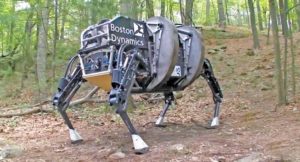

At present, the Army uses robots for a wide range of roles – including bomb disposal and reconnaissance. In the future, the world’s armies are developing entire classes of robots for battlefield usage, in categories defined as light, medium, and heavy.
There’s a lot of discussions today about what will robots do? What can they do on the battlefield? What can they not do? How many people does it take to operate? The idea for the robots is to have them operate several kilometres in front of a vehicle or infantry formation to detect and engage the enemy force before human personnel are engaged. The idea is that if a robot engages first, the risk is reduced and soldiers and manned vehicles have more time to figure out a plan of action when then advancing into contact with the enemy.
Unmanned aerial vehicles (UAV), more commonly called drones have become a separate class of drones because of the variety of essential tasks that they now perform. Thousands are now in service worldwide and growing. Drones are now being developed to operate autonomously and with manned teaming.
Artificial intelligence is being incorporated with robots. They are saving money and lives. Advanced robotics on the front lines are a powerful deterrent. Here is a selection of some developments which will make a difference.
Robotic Combat Vehicle
The US Army’s Robotic Combat Vehicle (RCV) programme aims to deliver robotic vehicles in three different weight categories; light, which is around five to seven tonnes, medium at around ten tonnes, and heavy which will be up to 20 tonnes. Throughout all the variants the Army wants the vehicles to be payload-agnostic, giving them the capability to carry a range of different mission packages depending on the environment they face.
The first lot of platforms will be used to inform and develop how to conduct operations with the assistance of robots at a company level and then transfer the lessons learned into concepts to employ at a brigade size.
Rock ‘Em, Sock ‘Em Robots
Advanced bipedal robots that can recognize people, enter buildings, avoid obstacles and pick up objects in their “hands” are being developed. They also have voice recognition systems that can take verbal commands. The military envisions using these robots to enter buildings in danger zones or to bring emergency medical supplies across battle zones to help wounded soldiers. For peace time, they will include robots that can serve drinks and snacks at public receptions, trade shows, parties, etc. Some will even be able to carry on limited conversations.
Robots that Mimic Human Movement
This robot, surprisingly agile and eerily anthropomorphic, is able to simulate the stress that soldiers put on their protective clothing, helping biohazard and other battle-wear makers refine their designs. They can walk, crawl and do calisthenics while wearing test suits and being exposed to chemical warfare agents in secure lab settings. The latest version of the robot can even climb stairs, a huge engineering advance, considering the complexity and weight distribution required for that act.


Live-Fire Trainers
In the near future, soldiers will receive their live-fire training and marksman training with the aid of special, robotically controlled Segway personal transport devices.
Specially armored Segways are called “smart targets.” They can move in a lifelike manner with unpredictable turns, stops and sprints, as would a real live target. Lifelike hardened plastic dummies on the Segways can be made up to look like enemies in uniform, terrorists or assassins. Such smart targets resemble live-fire combat much more than the old wooden pop-up targets that have been used for a century. Robotic live-fire training is sure to become routine in a few years.
Robot Mules


Agile “pack mule” robots will one day be commonplace on military missions in the field. The robot will carry gear, such as heavy backpacks that can slow down ground forces. The four-legged “mule” easily negotiates rocks and divots in the road and field. It is intended to follow a military unit of soldiers autonomously, catching up with the unit on field forays with supplies, including food and ammunition. Refinements have made the robot surprisingly quiet, an important characteristic on a secret mission. Future versions of the pack mule will be able to interpret verbal and visual commands.
MK2 Robotic Arm
The best that robotic arms have to offer, the MK2 offers top of the line dexterity. This arm could have a great impact in unmanned vehicles that can defuse bombs. The robotic arm features a modular construction and unparalleled freedom and dexterity and it can hold upwards of 25 kg.
The BigDog
Soldiers now have to carry a great deal of equipment with them. This puts immense strain on their bodies and can slow them down considerably. So the need for a machine to carry all that equipment is understandable. But some terrain can be difficult to navigate by machines, wheels ca get stuck or not be able to climb stairs, so the best solution is to create a robot that can walk on legs. The ideal solution is to look at nature for inspiration, and a four-legged robot offered the best stability without having the need for complex motors and equipment. BigDog can carry up to 20 pounds of equipment. Although for now it has to be controlled by a remote, in the future it will be completely autonomous. The power behind the BigDog is a one-cylinder gasoline engine connected to a computer, a fiber-optic laser gyroscope and even an IMU (inertial measurement unit) for keeping the robot standing on difficult terrains and inclined to up to 45 degrees.
The Throwbot XT
The Throwbot XT is versatile, stealthy and easy to deploy tactical robot which can efficiently be used during various search and rescue missions. These compact little bots can transmit audio and video signals from normally inaccessible areas, making detection of illegal and explosive materials more easier. It is lightweight (weighing only 540g) and have a maximum range of 36 meters. The robot is also equipped with an inbuilt infrared mechanism that activates whenever there is a low supply of light so that it can also operate in complete darkness.


Flybot
With the look and size of a lightning bug, this tiny robotic fly will be sent on reconnaissance missions in areas too dangerous for soldiers, including places contaminated by chemical or biological weapons. It weighs less than a pin and can be remotely controlled in flight. The Flybot engineers say it could also be used to find hidden chemical bombs. Later incarnations of the Flybot may also be able to rely on tiny solar power cells for propulsion.
Dragonfly Surveillance Robot
This little guy can fly off and give information about what to expect ahead, so that soldiers don’t run blind into buildings. Imagine a swarm of these bugs flying around and giving information. They are hardly noticeable by anyone, due to their small size. Applications of this technology could help search for survivors in accidents and in collapsed buildings.
Meshworm
One of the tiniest robots in development – about the size of a fingertip – the Meshworm moves and acts like a small earthworm. It propels itself inch by inch, using artificial muscles that mimic the way an earthworm moves, by stretching one part of itself forward, then pulling the rest of its body along behind it. The Meshworm can move silently into the tiniest places to report back data, such as temperatures inside a confined space. It can also record audio and maybe even video in future versions. Made entirely of synthetic fibrous material, it is nearly indestructible.
















